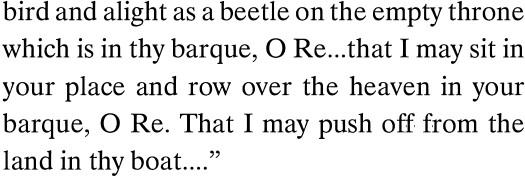Twilight of the Gods: The Mayan Calendar and the Return of the Extraterrestrials (16 page)
Read Twilight of the Gods: The Mayan Calendar and the Return of the Extraterrestrials Online
Authors: Erich Von Daniken












It goes on for pages like this. Heavenly portals are opened; gods descend in smoke and flames; pharaohs are allowed to fly with them; there are thunder and lightning all over the place; sand is thrown up into the air. Who is always behind it all? The gods. Whether it's in old India, in Tibet, in Japan, in the Bible (Ezekiel), or the Maya. Now look here, preach the Egyptologists: These texts are not be compared with any kind of reality. They are about the ascensions of deceased pharaohs. Well, somehow I doubt that. Looking at it from a modern perspective allows some quite reasonable and totally different conclusions, and there's nothing "anti-scientific" about them. Why don't the universities at least teach their students about the interconnections that are actually there? They could point out that a word like heaven does not necessarily have anything to do with a place of bliss and beatitude, and just as little to do with life after death. "Heaven" is also space-especially when it's mentioned in the same breath as attributes such as smoke, fire, quaking, noise, stars, and so on. What's unscientific about that? As long as the texts from each individual culture continue to be treated in isolation, then new insights will continue to be impossible.
In 1975, respected philosopher of science Paul Feyerabend, who taught for three decades in the University of California, Berkeley, announced his "anything goes" approach. It's another way of saying that anything is possible. The scientific world reacted with horror because "anything goes" or "anything is allowed" was a contradiction to the long-held belief in a continual scientific process of establishing the truth. Feyerabend postulated, however, that the results of any scientific method are limited by the methods themselves.' Indeed, many scientific innovations thrive not because methodological rules have been followed, but because they have been broken. Feyerabend was right, and his "anything goes" does not contradict scientific progress at all. So a comparison between the mythologies of ancient Egypt and Central America may go against the academic grain, but it does bring new answers and therefore the desired insights. Breaking the rules means eating from someone else's bowl-but only when there's a good reason for it. And there's plenty of them!
 ivine Intervention
ivine Intervention
Spanning the gap between Egypt and Central America makes a whole lot of sense. In both places flaming gods rise into the heavens, even though-from the point of view of the archaeologists-the two cultures existed at different times. But who can say with absolute certainty where the origins of these cultures lay and whether there really were any transatlantic connections all those thousands of years ago. In the Museum of Leyden in Holland, you can see a jade tablet known in the scientific literature as the Leyden Plate. It was found in the Maya city of Tikal (now Guatemala). Following the tricky-to-translate name of a god, it reads: "the lords of the heavenly family of Tikal descended." Regardless of whoever these heavenly rulers may have been, it was really no different in ancient Egypt (or in China, Japan, Tibet, or India, come to mention it).
